When Can You Start Feeding Deer Corn
Tips, Concerns, Results, and Strategies Deer Feeders 101
Deer feeders create an interest for deer hunters, wildlife enthusiasts, and animal lovers alike. Whether it's simply a wildlife feeder in the back yard, in the wood lot next door, or a vital piece of your deer management plan, chances are you will encounter the want/need to own a deer feeder at some point or another. Surprisingly, deer feeders come in a variety of sizes, designs, and uses. From the general wildlife feeder to a critical supplemental feeding program, deer feeders can certainly pull their weight no matter the use. Given such use, it's respectable to put together a string of helpful information, tips, strategies, and uses. Welcome to deer feeders 101.
Deer Feeder: A tool used to supply feed, usually in the form of grain (corn) or a specially blended deer/wildlife feed for nutrition, to deer or wildlife in supplemental feed programs.
Why Feed Deer?
More often than not a deer feeder's use occurs on the most basic level you can imagine. Simple and consistent corn feeding throughout the winter months appears to "help" deer and other wildlife through cold temperatures and heavy snowfall. In fact, feeding deer in the winter is a big concern for deer, deer managers, and many states. This is why it is included front and center in this article.
Intervention in the form of a couple hundred pounds of "deer corn" can spell disaster for deer. This is why states all across the northern stretches of the country restrict or outlaw the use of bait and feeding of deer. Some of this concern undoubtedly stems from the possible negative outcomes of gathering large numbers of deer in one place…diseases being the concern. Have you heard of Chronic Wasting Disease (CWD)? That's one of the big ones! However, another more likely concern that often goes unknown to the person supplying the feed is called acidosis. Acidosis occurs when ruminants (deer) consume large quantities of carbohydrates that are low in fiber, also known as corn toxicity. A deer's diet during the winter consists of high fiber woody browse, not low fiber carbohydrates. With a sudden intake of grain, an increase and change in the microbial population in the rumen causes a fatal increase of lactic acid. Dehydration as a result of the buildup of lactic acid can be fatal in 24-72 hours.
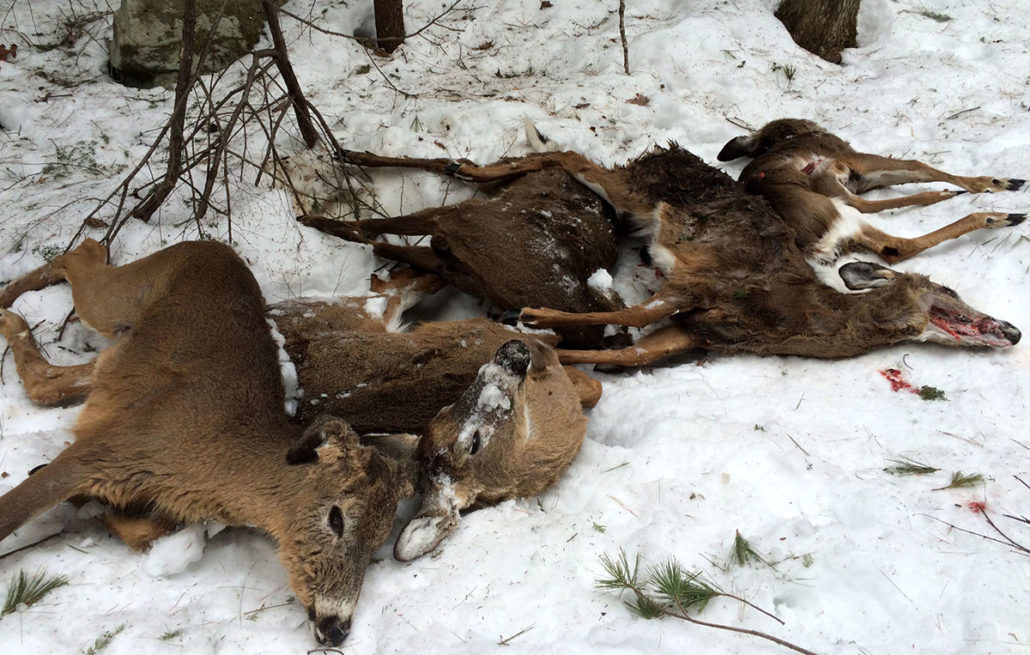
Photo: New Hampshire Fish and Game. Five of the twelve deer found dead due to winter feeding in N.H.
However, concern over acidosis is waved throughout the Midwest and in areas where deer are already consuming corn. The corn maze of states in the Midwest such as Indiana, Illinois, and Iowa have so much corn readily available (either standing or left behind from the combine) during the winter months that the deer's rumen and microbial population is adjusted for feeding. This also is true for properties and programs where supplemental feed is already taking place.
The well-being of the wildlife and deer should always be taken into consideration first before your wants and needs of either supplementing nutrition or for simply observational purposes.
The Results of Supplemental Feeding
For the more advanced deer managers and deer hunters, supplemental feeding always looms in the back of the mind. The number one reason for interest in supplemental feeding is always centered around the obsession of antlers…at least for the most part. It is widely known now that age, nutrition, and genetics (in that order) are the important factors that determine antlers and a buck's score. Age and nutrition in particular are what we as deer managers can actively manage. Age is simply managing your trigger finger and the ability to age deer on the hoof accurately, leaving nutrition as a 365 day a year obsession.

Habitat, food plots, and supplemental feeding are all management efforts we as deer managers can continually improve it seems. For the point of this article we will focus on supplemental feeding.
The big question is "can a supplemental feeding program increase the size and score of the bucks on my property?". The answer is yes it can. If you ask the question you can be sure a deer biologist or two have as well, and they have found the answers through research.
"A study in Texas found that bucks fed a 16% crude protein diet grew antlers that scored 20 inches higher Boone and Crockett, than did bucks fed 8% crude protein (Hamel et al. 1989)" – MSU Deer Lab.

Deer Feed Requirements
16% crude protein is the agreed upon percentage of protein intake that maximizes antler growth, however, it doesn't tell the whole story. Often time feed containing 18-20% protein can help balance protein intake that is significantly lower in the other portions of the deer's diet, when natural browse and protein levels of food plots/crops might dip below 16%. It also important to note that the protein requirements of deer depend on age. Mature adults do not need the higher protein requirements that fawns or young bucks need when developing. – MSU Deer Lab.
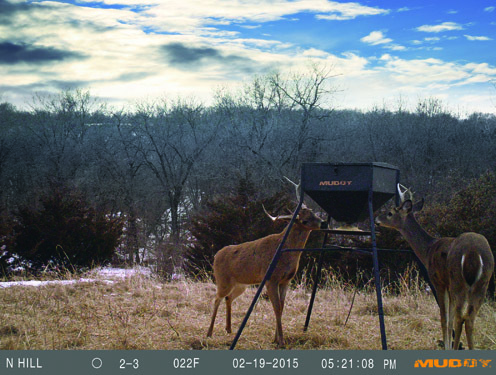
Other than protein, minerals are also a thought pertaining to deer feed. In general, macro-minerals and micro-minerals are fulfilled by vegetation or eating the soil in natural licks. However, when it comes to deer management, it is always best to be safe. Identifying limiting factors of a property such as cover, water, or food is easy. When it comes to minerals a generally safe approach is ensuring the deer feed of choice contains the basics. These are mainly calcium and phosphorous.
Deer Feeder Advantages and Design
Knowing that a supplemental feeding program supplies benefits to the herd, and knowing what deer feed should consist of, the focus can now be turned to the feeder itself. A deer feeder offers several advantages over simply placing feed on the ground. Why? By knowing what goes into deer feeder designs, you discover their advantages. Access to feed and protection of feed are the most obvious advantages. The original thought towards a feeding program is usually brought on by a hard winter, or by the need to create an attraction for your trail camera/hunting site. The next thought is in the process you are currently in…research! You are trying to find out exactly what deer feed to use, if supplemental feeding programs work, or you are looking for deer feeder designs. That last one…deer feeder designs is because you are thinking of building your own. Why not, right? Seeing as how this is deer feeders 101, we have arrived at the same conclusion…sure, why not? Here is what makes a great deer feeder design…or a checklist if you will, to what a feeder needs in order to be successful.
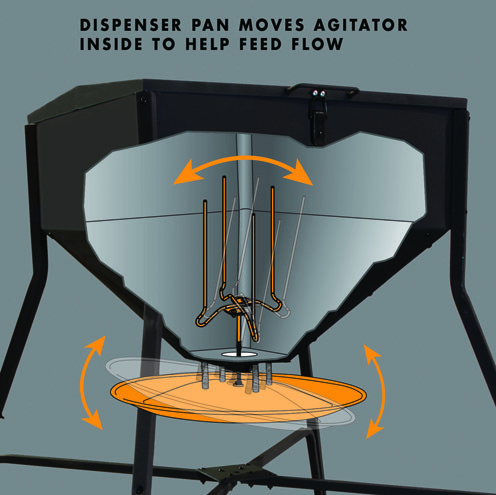
- Waterproof – Nothing is worse than soggy, spoiled, and molded feed.
- Locking Lid – A locking lid gives you the satisfaction that the feed is not only waterproof but its safe from nuaisance animals.
- Durable – it has to survive rough weather and some of the biggest raccoons that appear more bear-like than a raccoon.
- Dispenser – A deer feeder needs a dispenser of some sort. This comes in the form of a port, a broadcaster (spinner), or a port/agitator.
- Large Quantities – Feeders with large quantities equate to less time filling. This is less time on your part but also less pressure associated with the feeder.
Sure you can build one or go ahead and come the conclusion that buying a sturdy feeder will last longer and will inevitably be more successful. We offer a 200lb Gravity Feeder, and by design, it features everything it needs…simplified to be a very successful deer feeder.
Muddy 200 LB. Gravity Feeder | Muddy Outdoors Product
(Video) MGF200 Gravity Feeder is unlike any gravity deer feeder on the market. It features an adjustable spring-loaded dispenser and agitator. This feature keeps the feed broke up and dispensing while animals feed. The feed is lockable, and the lid is user friendly but cannot slide off like other feeders. If you are looking for a new gravity deer feeder, check out Muddy Outdoors.
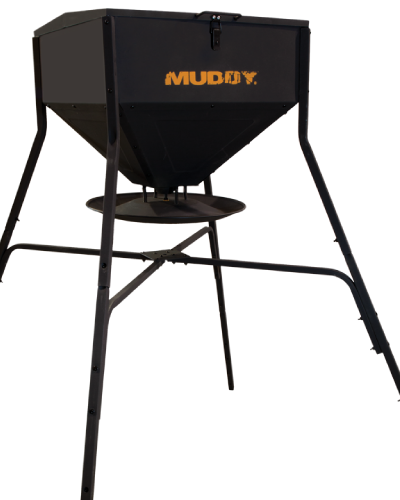
PRODUCT FEATURES
- Waterproof
- Locking Lid
- Spring-Loaded Dispenser and Agitator
- Dispenser Easily Adjusts
PRODUCT SPECS
- CONSTRUCTION: Steel
- HEIGHT: 61" Fill Height, 42" Feed Height
- CAPACITY: 200 Lbs./ 33 Gallons;
- WEIGHT: 44 Lbs
Deer Feeder Strategies and Tips
If applicable, and if legal, these tips can be taken into consideration to either spike the efficiency of the feeder or the scenario of hunting over the feeder. Either way, these feeding tips excel the situation beyond a feeder sitting in a field! The diagram below helps paint the scene for your imagination.
Deer Feeder Placement
Obviously, if you are in the research phase of either building or buying a deer feeder chances are you have a spot already picked out on your hunting property. What makes a "good spot" for a feeder? To start, high traffic areas are a must. However, you also have to factor in accessibility of a truck, ATV, or side-by-side that can reach the feeder. It is also important to think about what else should be paired with a feeder such as water, other food sources, security, proximity to bedding, and in states where it's legal, your stand or blind. Another critical thought should be thrown in concerning human pressure. If the feeder is out in the open such as a large crop field or can be seen by someone driving on a road the anxiety of deer at the feeder will be high (not to mention potential poaching or theft problems). Keeping the feeder back in secluded, low anxiety areas can increase feeding and feeder success. Considering these factors can get a bit overwhelming so here is a list in order of how you should think about deer feeder placement.
- High traffic area
- Accessible via truck/ATV
- Human pressure/seclusion
- Ask yourself the question: "Does it work with my hunting strategy?"
- Proximity to other food sources
- Proximity to water
- Proximity to bedding

The diagram above is a common, or a slightly above average Midwest hunting property (the terrain and amount of timber is a blessing). As you can see, feeder site #1 utilizes all of the checklists and even goes above and beyond by integrating a bit of hunting strategy. Water, food sources, a plot screen, bedding areas, and access are all present allowing the site to be optimized for deer usage and traffic. You will also notice another feeder site…this is where hunting strategy really takes off.
Deer Feeders and Hunting Strategies
Even if your state does not allow hunting over bait you can still create the attraction and central hubs for deer socialization. These usually take the form of food plots and crop fields, but by adding other factors like water, feeders, scrapes, and minerals you can create an even more popular destination that imprints in the mind of the deer herd. This impression stays with a deer even well after the bait is removed. Hunting strategy in relation to deer feeders should focus on this aspect, again regardless of whether or not bait is legal to hunt over or not.
From the diagram, you can see two feeder/bait sites. By creating two "social hotspots" pivoting on food sources you can create hunting opportunities for two scenarios. The wind dictates hunting…period. Bow hunters live and die by this simple observation and strategy. By installing and running two feeder sites, one for north winds and one for south winds, you create hunting opportunities regardless of the prevailing wind. This reiterates the fact that there is much to think about before a deer feeder is placed and filled!
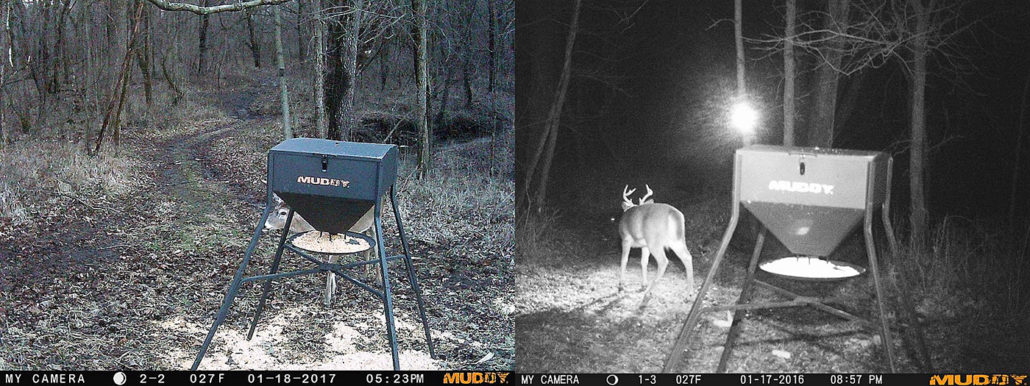
Deer Feeder Site Necessities
What is the ideal set up for a feeder site? Think about the obvious needs. With deer coming in continuously the feeder makes the ideal site for trail cameras. Beyond cameras, it also is an ideal site to create the idea of "social hotspots". Mineral blocks and scrapes are also items that can add to the attraction and usage of the feeder sites. When it comes to trail camera usage check out the blog below on Trail Camera Tips. It gives insight into the setup, settings, and tips for each scenario such as a camera over feed.
A couple more tips for feeding deer out of a feeder include two tips that can greatly help the success you achieve with a site. When filling/re-filling feeders, spread a bit of feed around the feeder…especially when you are introducing a feeder for the first time on a hunting property. Also be cautious of the scent, not for pressure but for nuisance animals. Take hand sanitizer or a field spray with you to spray your hands before going from the feeder to your trail camera. Feed scent on a trail camera could create enough interest for a raccoon to destroy the camera in search of more food!
Conclusion
Is a supplemental feed program beneficial for your deer and hunting? Yes. Can a deer feeder integrate and enhance your hunting strategy? Yes. Should you use a deer feeder on your hunting property? It depends… If you have the need or want for more attraction, can keep up with the demands of running a feeder, and have checked your state's regulations on feeding deer then the answer is yes! Keep an eye out for more content on deer feeders and hunting strategy on the Get Muddy Blog.
Was this article on deer feeders 101 helpful? Leave a reply! Whether it's a simple question or comment we would appreciate the feedback!
Source: https://www.gomuddy.com/deer-feeders-101-deer-feeding-tips-concerns-strategies/
0 Response to "When Can You Start Feeding Deer Corn"
Post a Comment